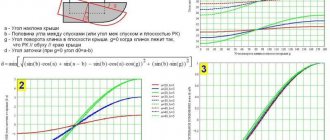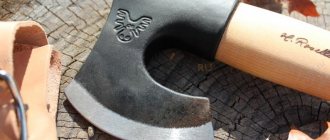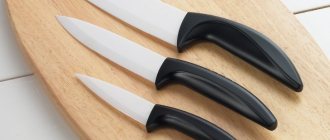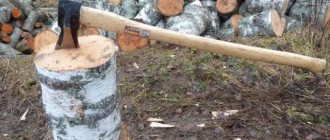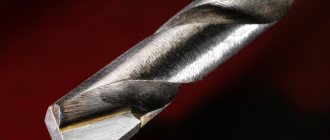The ability to sharpen a blade has always been an important attribute of a real man. And if previously life depended on it, now it is the prerogative of gunsmith collectors and experienced hunters. They can appreciate the correct angle of sharpening knives.
Many modern professions also require sharp tools. Not to mention housewives who obviously will not be happy to cut bread or sausage with a blunt object.
Why does the knife get dull?
Sharp objects are dangerous because you can get hurt when using them. But even more trouble will come from a dull chef's knife, which can slip and easily injure your hands.
The blades sold in the store are sharp and easy to work with. But their shelf life depends on operating conditions.
Following a number of recommendations will help keep your kitchen knife sharp longer:
- during storage, the cutting edge should not touch surfaces that have a high density;
- cutting should take place on special boards made of wood or plastic;
- blades of all types must be used for their intended purpose, avoiding shock loads on blades whose sharpening has a small degree;
- Immediately after use, knives should be washed and dried.
The sharpness of the cutting edge decreases for several reasons:
- Impact of organic acids contained in products on the blade material.
- Impacts from a fall.
- Cutting on hard surfaces such as stone countertops or ceramic cookware.
- Uneven load on the cutting blade when the composition of the products is uneven (the blade hits bones, tendons when cutting meat).
- Exposure to aggressive chemicals and high temperatures during cleaning.
- Improper use.
If the knife is intended for cutting the fillet of fish, then when opening cans with it, the blade will be damaged. The nature of the RK violations depends on the material from which the blade is made.
Knives made of stainless steel are resistant to aggressive environments, but without proper care, rust appears on the surface of the blade. Such blades are easy to sharpen, but this process must be carried out more often.
Carbon steel has increased strength, such blades are more difficult to sharpen, but they retain their sharpness longer. With insufficient care, the metal quickly becomes covered with rust.
By combining hard and soft steel in industrial production, alloys are created that imitate the blacksmith forging inherent in Damascus blades. Knives are made primarily for hunters using this method.
Products made from zirconium alloy are characterized by increased fragility. These ceramic knives are designed for smooth, soft products and keep their blade sharp for a long time. A special tool is required for sharpening.
Calculate the angle of descent on the knife.
Work as a musat
Musat is a metal tool designed for straightening knives. It’s not hard to remember how meat department sellers used to rub the cutting edge of one knife against the butt of another. This happened due to the absence of musat at the workplace.
The tool corrects microscopic bends in the cutting edge by running the blade along the side grooved surface. The hard surface of the musat has a slight abrasive effect, as a result of which a small layer of knife metal is removed during the dressing process.
Before editing, you should check the hardness of the knife blade. If it is less than 50 HRC, then the musat will remove too much metal, and the knife will quickly become unusable. If the hardness exceeds 60 HRC, then the use of musat may become useless, because with the appropriate mechanical characteristics, edge bends cannot be corrected.
There are several techniques for using musat. The most common involves the following algorithm of actions:
- Place the heel of the blade closer to the guard on the handle of the tool.
- Position the blade at an angle of approximately 20°. Since only editing is done, the blade is not sharpened, the angle can be set approximately.
- Run the entire cutting edge (from the heel to the tip of the blade) along the ribbed surface of the musat, while simultaneously moving the blade away from the guard.
- Change the side of the blade and repeat the manipulation.
- Treat the blade in this manner on both sides until cutting properties are restored. Usually 5-10 repetitions are enough for this.
You should not run the blade over one point of the musat. Moving the blade along the tool prevents wear. Otherwise, the device may begin to leave scratches.
You should not rush while working. Speed editing looks impressive in cooking shows, but is completely unnecessary in practice.
The type of musat used should be taken into account. Modern varieties with a ceramic surface or diamond coating have a significant abrasive effect. Such models differ in the principle of operation from the classical tool; they simultaneously remove the metal of the blade. When using such tools, you should more accurately set the angle of the blade and reduce the number of approaches when editing to two to four.
Knife device
Any knife consists of a metal or ceramic strip and a handle, which is made of wood, plastic, ceramics or other materials. Depending on the way the handle and blade are articulated, knives can be fixed, folding or detachable. The handle can also be positioned perpendicular to the cutting blade.
The blade has a RC formed by two or one microfeed. Depending on the shape of the perpendicular section, the cutting edge can be formed by a bevel without microfeed.
The part of the blade opposite to the RK is called the butt. It can also have a sharpening, as in the case of a double-edged knife. The section of the blade that is adjacent to the handle and has no sharpening is called the heel.
Caring for a hunting knife
Basic rules for caring for a hunting knife:
- It is necessary to have your knife professionally sharpened regularly to ensure that its edge is always sharp.
- Over time, the blade becomes dull and sometimes rusts. To give it shine, you need to clean it with steel wool, which is soaked in special oil. And to remove rust, its surface must be treated with polishing paste.
- If the knife handle is made of wood, then caring for it requires special care. Due to the possible drying of the wood, it is recommended to keep the blade away from the stove, warm radiators or open sunlight. If the knife handle is made of leather, it can also be treated with special products.
Shapes and sharpening angles
Depending on the purpose of the knife, there are several blade cross-section shapes:
- Scandinavian, when the descent connects the butt with the RK and the cross-section has a wedge-shaped shape. A small angle is convenient for cutting, but does not withstand impact loads well.
- Scandi - the RK angle is more obtuse than in the first case. It withstands shock loads better, but cuts worse.
- Razor, when the slopes have a concave shape, which provides a small angle for the cutting edge and ensures high cutting quality. This sharpening is used for straight razors. It is not recommended to subject the blade to shock loads.
- Lenticular - the descents are curved, while the angle of the RK is of greater importance. This cross-section is typical for axes intended for chopping.
- One-sided - the descent is designed on only one side of the blade. This type is typical for carpentry tools and knives made in Japan.
- European - a wedge-shaped descent from the end turns into a micro-approach at the edge. This cross-sectional shape of the blade provides an increased angle compared to the Scandinavian cross-sectional shape, due to which the blade better tolerates shock loads, allowing chopping movements.
Electric knife sharpener.
Table of values for different knives
A table is used to determine the optimal sharpening angle.
| Knife type | RK sharpening angle in degrees |
| Kitchen | 55-60 |
| Chef | 25-30 |
| For fish | 25 |
| For fillet meat | 10-15 |
| For cutting and deboning | 25-30 |
| For frozen fish and meat products | 35-45 |
| Vegetable | 35 |
| Japanese | 15-18 |
| Special | 40 |
| Folding | 20-25 |
| Tourist for cutting | 30-35 |
| Tourist for cutting | 40-45 |
| Hunting | 40-45 |
| For cutting | 25-30 |
| Shoe | 30-40 |
| For cutting | 20-25 |
| Straight razor | 10-15 |
Practice
Theory is good, but you need to practice as much as possible, then your hands will remember and the whole process will settle down in your head.
The most important thing in sharpening is maintaining the angle correctly. And this requires practice. The more you practice, the better you will get. Well, as in any business that requires skill and patience. I dare to assure you that you will not be able to sharpen a knife the first time. But with due diligence... well, you get the idea.
Read also: How to cut round glass
Tool
So, for sharpening you need a whetstone, a little bit of any machine oil and a knife, which we will sharpen.
Grindstone
Buy a simple block at any hardware store. It comes in the shape of a boat, but it’s better to buy a double-sided one and a longer one. When you start to succeed, you will buy something more respectable. Diamond bars, for example...
The bar should not be shorter than 150 millimeters. You can see why this is so simply by trying to sharpen on bars of different lengths. The longer the block, the more convenient it is to sharpen.
Oil
We will need machine or gun oil. Oil is needed to lubricate the whetstone during the sharpening process so that the whetstone does not become clogged with metal particles.
Under no circumstances should you use organic oil, such as sunflower oil. The block will instantly become greasy and can be thrown away.
Knife
For the first time, do not take a new knife or the knife you use all the time. Find some knife that you don't mind ruining. This is how you train. My knife for experiments was this, old, old kitchen knife.
Well, we have the tool, let's start sharpening.
Sharpening process
Let's get comfortable. Place the block on the table in front of you, with the short side facing you. You can place something like a rubber mat or newspaper under the block so that it does not slide on the table when sharpening.
We take a knife and start sharpening it.
The sharpening process takes place on sharpening stones of different grain sizes. From large to small. The larger the grain, the faster the metal is removed from the blade. And the smaller the grain, the smaller the microsaw on the cutting edge, and the smaller the microsaw on the cutting edge, the longer the knife will remain sharp.
Since we are sharpening a kitchen knife, we do not need razor sharpness; it is enough that the knife cuts food well. I will tell you about checking the sharpening result below. And now I will repeat.
The block lies on the table, with the short side facing you and the large grain facing up. Easily and naturally, without much pressure, we begin to form the cutting edge. Pre-drop a few drops of oil onto the bar.
The movement shown in the picture below.
Please note that the movement of the knife on the stone should be clear and consistent. From mouth to tip.
They brought it to the edge, tore it off and again. Repeating this movement many times, we achieve the formation of a burr on the back side of the blade, along the entire length of the cutting edge.
Repeatedly - I “bent” this a little, of course. Kitchen knives, if they are not “Japanese”, are made of fairly soft steel; it will be enough to make 40-50 movements to obtain the desired result. Don’t forget to add a few drops of oil as the bar becomes dirty.
A hangnail can be seen or felt. Run your finger across the cutting edge, you feel that your finger seems to be clinging to something. There is some roughness felt. This is a burr, which should be uniform along the entire length of the cutting edge.
Well, we're done with one side. Now you need to perform the same actions on the other side.
You can sharpen the other side by holding the knife by the handle with your left hand, but for example, this is not convenient for me, so I hold the knife in my right hand, but I sharpen it not away from myself, but towards myself.
We carry out the procedure for obtaining a burr along the entire length of the cutting edge on the other side of the knife.
Now you can move to the finer side of the whetstone. On the shallow side of the bar, you need to repeat everything described above.
That's the whole sharpening process. It seems not difficult, but it requires certain skills and a lot of patience.
Methods for determining the sharpening angle
Having bought a new kitchen knife with a good sharpening, it is advisable to immediately measure the angle of the angle of rotation in order to adhere to this value in the future. If you do not have a special device, you can use scissors with long cutting ends.
The knife rests with the RK at the point where the blades diverge, then they are closed until the gap near the microfeed disappears. The angle of spread of the scissors projected onto the paper is measured using a protractor.
You can also use a soft candle to determine the sharpening angle of the blade. To do this, a layer of softened paraffin is applied to the side edge of an oiled wooden stand. The tip is inserted into it in one motion and held in this position until the soft mass hardens. The resulting print is photographed, and the required angle of the RK is determined using a protractor.
Sharpening instructions.
Methods for checking the blade tip
Blade sharpness is the most basic requirement for any type. The tool must be safe and reliable for a wide variety of jobs. There are several methods for checking whether a blade has been sharpened well.
On paper
Take a sharpened tool and an A4 paper sheet. The process is this: you should cut the paper, and if at the same time the blade begins to move to the side, then the sharpening is done at a low level, and if the cut is even, then the blade is quite sharp.
On a tomato
In addition to kitchen options, you can also test all types of blades. The meaning of the test is this: take a fresh tomato and cut a slice. If the blade moves to the side, it means that the sharpening was poorly done, but if it is smooth and without difficulty, then the work was done at the highest level.
Testing on hand hair
The knife is drawn against the direction of hair growth without touching the skin. In this case, the blade should cut the hairs.
Angle Holding Devices
The correct sharpening angle of the cutting edge of the blade will help to hold the device in which the knife is fixedly fixed at the required angle to the abrasive surface moving across the wheel.
The blade can also be processed on a machine designed for sharpening. But the high speed of the abrasive wheel increases the likelihood of errors when working with a beginner. Fixed blade tools must be adjusted by a professional.
Electric devices for sharpening the RK do not require special skills and allow you to set values on the sharpener in the range from 15 to 30°.
How often should you sharpen?
It is believed that knives need to be sharpened as they become dull, but experts recommend this “event” be carried out at least once a week. In this case, it will be possible to maintain the cutting ability of the tool, and the sharpening itself will take place quickly and efficiently.
If we are talking about manual/mechanical sharpeners with wheels or musat, then they can be used at least every day - the knife will be sharp, but not for long. These devices are needed for straightening the knife, and not for fully sharpening it.
Grinding the knife after sharpening
After processing the blade, it is recommended to grind it using a block or other abrasive. Then, to obtain an optimal result, it is recommended to continue polishing with a fine-grained material. A leather belt works well for this purpose.
The belt secured on one side is lubricated with goyi paste and pulled by hand through the loop at the other end. Polishing and finishing are done with the butt forward, alternately on each side, gradually reducing the pressure on the belt. Grinding is considered complete when the blade surface is brought to a mirror shine. This method can be used to edit both a shoemaker's knife and a folding knife.
Bottom line
When purchasing a hunting knife, it is best to choose medium-hard steel. Indeed, in case of unforeseen situations in the forest, you can correct the blade with an ordinary whetstone or, if you don’t have one, use any found stone with a smooth surface for sharpening.
Previous
Making knivesKnife from scissors: creation in 4 steps
Next
KnivesHow to use a knife correctly: mastery of kitchen and cutlery
Features of Japanese models
The Japanese knife has a one-sided sharpening at an angle of 15-18° and looks like a French chef's knife. The wide blade and the downward tip of the blade on the side of the butt allow you to make movements when cutting only up and down, without swinging. Skill is required to operate this tool.
Sharpening of knives for Japanese cuisine is done only by hand using a water stone. Magnetic blades do not require sharpening because they have a self-healing structure.
Previous
KnivesKnife handle material G10
Next
Kitchen knivesHow to store knives in the kitchen
